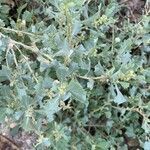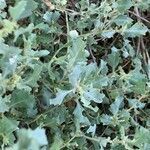Spreading to erect herb branching from base, to 30 cm high. Leaves thin, broadly obovoid, apex rounded, base cuneate and passing into petiole ½ length of lamina, in all 15–30 mm long, margin undulate to sinuately lobed, upper surface glabrescent, lower surface scaly. Male flowers clustered in terminal axils. Female flowers in scattered axillary clusters. Fruiting bracteoles sessile or almost so, bluntly deltoid to circular, swollen, hard, smooth, c. 3 mm long and wide at apex, connate except at the rounded apex, valves herbaceous, forming a narrow denticulate margin around apex of bracteole; appendages absent. Seed circular, radicle lateral, erect.
Mostly perennial, monoecious, dwarf shrub, 0.3-1.0 m high, grey-to white-squamous. Leaves 20-70 x 10-40 mm, deltoid-oval or elliptic, base concave, apex blunt, sinuately lobed. Male flowers in ± terminal clusters. Female flowers in 2-8-flowered clusters lower down. Fruiting bracts 2-4 x 2.5-3.5 mm, roundish oval or roundish deltoid in outline, lower half inflated becoming woody or spongy, upper half with 1-4 shallow or sharp teeth on both margins.
A spreading shrub. It grows 0.3-1 m high and spreads 1-2 m wide. It grows each year from seed. The branches are rigid. The leaves are 5 cm long and wedge shaped. They have lobes or irregular teeth along the edge. The upper surface is green and they are mealy white underneath. The flowers are small. Male flowers are round and in the upper axils of leaves. The female flowers occur in clusters in the lower axils. They are both on the same plant.


